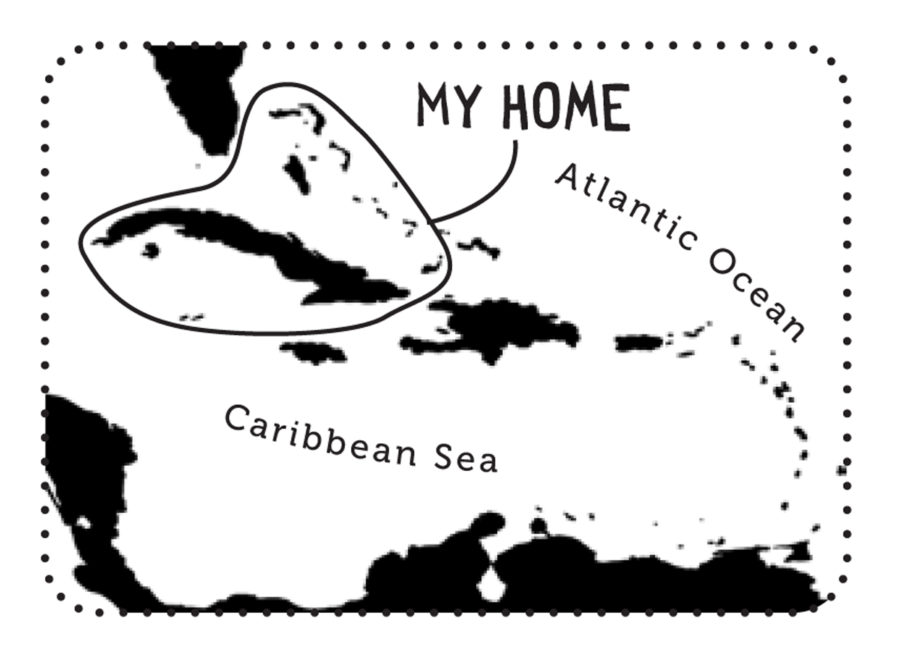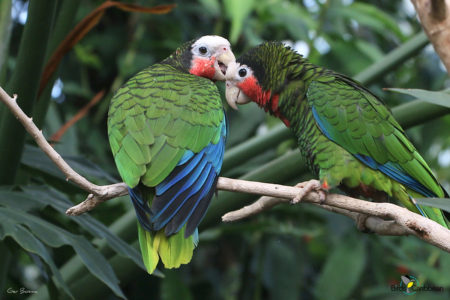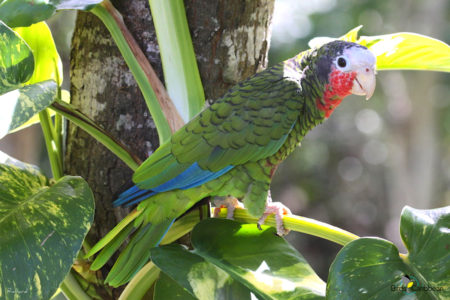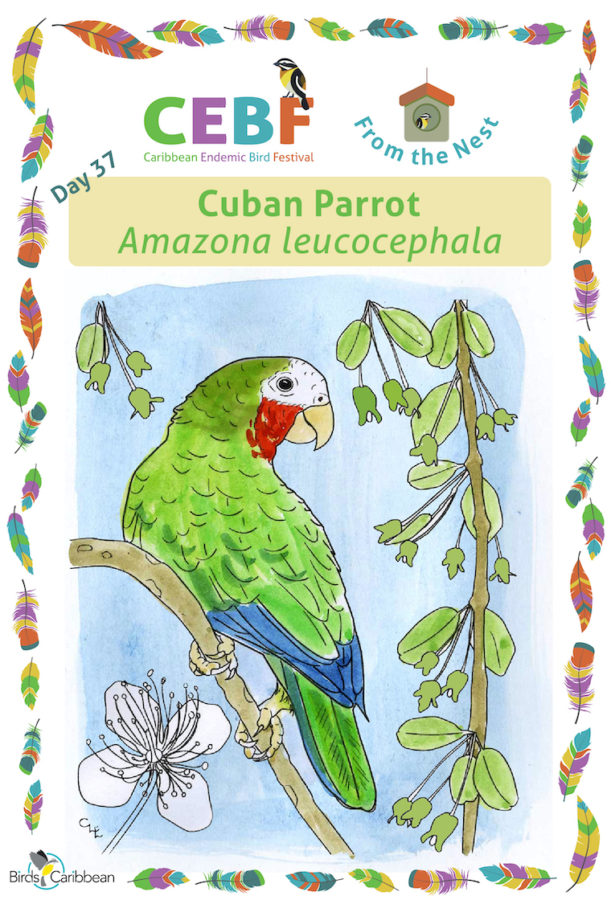Celebrate the Caribbean Endemic Bird Festival (CEBF) with us in our virtual “From the Nest” edition! Have fun learning about a new endemic bird every day. We have colouring pages, puzzles, activities, and more. Download for free and enjoy nature with your family at home.
Endemic Bird of the Day: Cuban Parrot
 The Cuban Parrot, formerly known as the Rose-throated Parrot, is not actually endemic only to Cuba. It also occurs on two islands in the Bahamas (on Abaco and Great Inagua) and the Cayman Islands. It is a pigeon-sized parrot (~30 cm). Coloration varies between the islands but this attractive parrot is mostly green with a pinkish-red chin, throat, and cheeks, and purplish abdomen. The forehead and eye ring are white and flight feathers are soft blue. The bill and legs are yellow. Is a very noisy bird, especially when they are in flocks in the non-breeding season. During the breeding season they are usually in pairs.
The Cuban Parrot, formerly known as the Rose-throated Parrot, is not actually endemic only to Cuba. It also occurs on two islands in the Bahamas (on Abaco and Great Inagua) and the Cayman Islands. It is a pigeon-sized parrot (~30 cm). Coloration varies between the islands but this attractive parrot is mostly green with a pinkish-red chin, throat, and cheeks, and purplish abdomen. The forehead and eye ring are white and flight feathers are soft blue. The bill and legs are yellow. Is a very noisy bird, especially when they are in flocks in the non-breeding season. During the breeding season they are usually in pairs.
In the Cayman Islands, the parrot is called the Cayman Parrot and it is the national bird of the Cayman Islands. In the Bahamas it is called the Bahama Parrot, and in Cuba – Cotorra Cubana.
In Cuba, the Cuban Parrot lives in dense woodland (including the Isle of Pines). It inhabits native broadleaf and pine woodlands in the Bahamas, and dry forest and agricultural areas in the Cayman Islands. The parrot has also been recorded in savannas with palm groves, mangroves, plantations and gardens. They eat a variety of fruits and seeds, including including gum elemi (Bursera simaruba), poisonwood berries, wild guava, mastic, white torch, mahogany seeds, and fruits of many species of palms. For nesting they mainly use old woodpecker nest holes and dead palms that have lost their foliage. The Abaco Island population has the unique behavior of nesting in limestone crevices in the ground, which makes them vulnerable to predation by feral cats and raccoons. Females lay 3-4 white eggs; breeding is from March to September.
The Cuban Parrot was formerly much more numerous and widespread. Christopher Columbus was so struck by the numbers of parrots when he made landfall in The Bahamas in 1492, that he wrote in his log, “flocks of parrots darken the sun.” Sadly, this parrot has been extirpated from much of its former range due to habitat destruction and capture for the pet bird trade. Hurricanes also kill birds and damage habitats. Some conservation actions have helped: such as the creation of the Abaco National Park in 1994 to protect the parrot and campaigns to educate people that capture of wild parrots is illegal and they should not be kept in cages. But more work is needed to ensure the long-term survival of this near-threatened species. Learn more about this species, including its range, photos, and calls here.
Colour in the Cuban Parrot!
Download the page from Endemic Birds of the West Indies Colouring Book. Use the drawing above or photo below as your guide, or you can look up pictures of the bird online or in a bird field guide if you have one. Share your coloured-in page with us by posting it online and tagging us @BirdsCaribbean #CEBFfromthenest
Listen to the call of the Cuban Parrot
The Cuban Parrot is very noisy, especially when perched in a flock. It has a wide variety of screeches and calls. In flight, it utters a harsh squawk squawk.
Puzzle of the Day
Click on the image below to do the puzzle. You can make the puzzle as easy or as hard as you like – for example, 6, 8, or 12 pieces for young children, all the way up to 1,024 pieces for those that are up for a challenge!


Activity of the Day
FOR KIDS & ADULTS: Enjoy the videos below which show the Cuban (Bahama) Parrot in the wild. The first video shows a Cuban Parrot feeding on tamarind seed pods in Matanzas, Cuba. The Bahama Parrot video by Scott Johnson and the documentary from 2011 provide details on the threats to Bahama Parrots in Abaco and Great Inagua and research and conservation actions by the Bahamas National Trust to protect the parrot. The fourth video is QUINCY’S SONG – a rap song created for the first Rare campaign in the Bahamas to protect the Bahama Parrot in 1992.
Learn more about the Cuban Parrot in these articles:
Amnesty for Pet Parrot Owners on Cayman Islands
Post-Irma, Parrots in the Abaco Pinelands Are Holding Their Own
Hurricane Dorian Recovery: An Update on How Our Appeal Funds Are Being Used
Working to Save and Protect what’s Ours— That’s our CAWS

